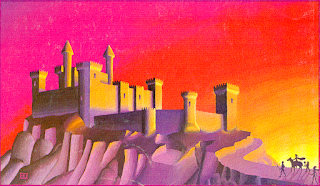Here's the deal, I don't want to be counting every time a wand is used. Nor do I want the player to have any sort of concrete idea of how many more uses he can get out of the thing. At best I'd prefer if they could, via spells such as detect magic or identify or whatever, get a general sense of how potent the magic in the wand is, which would help them determine the expected reliability of the wand.
Wand Potency
Rather than granting a finite number of charges for magical sceptres--a number which must be tracked each time the wand is used--I give it a potency level ranging from 0 (Spent) to 3 (Virile). The number represents the number of 6-siders the player rolls against the DM's single 6-sider each time he/she uses the wand. If the Player rolls higher than the DM then the wand works without a hitch. If the DM rolls higher (odds ~ 1:86) then the wand is downgraded to WandCon 2 (Functional). It still works, but, from now on, whenever the wand is used the player rolls only 2d6 to check for success. If (when) the DM's 6-sider beats the player's 2d6 (odds ~ 1:11), then the wand is degraded to level 1 (tepid). Now rolling a single d6, this thing is on its last legs. Another loss (odds ~2:5) results in the permanent dissipation of the wand's magic.
Tie Roll
A tie result in the wand wars could go either way; maybe your wand functions normally and nothing unusual happens at all. Or a tie might result in massive degradation of its power or even bring about a zombie apocalypse. Here's how it works:
If the wand roll results in a tie, another roll is immediately performed, this time at 1 level lower, i.e., a virile (level 3) wand would roll only 2d6 for the tiebreaker, a functional wand would roll 1d6, and a tepid wand would roll 1d3. If the player rolls higher than the Cool J--who continues to roll a single 6-sider--then the wand is not diminished. But if the DM rolls higher, then the wand is permanently downgraded. Multiple ties can result in even lower degradation of the wand; if a virile wand ties on 3d6 and on the 2d6 tiebreaker before finally losing the roll at 1d6, then the wand is downgraded to tepid thereafter.
When the player is rolling a d3, odds are pretty good that the DM is gonna' win and the wand will be spent. But things are even worse if they roll another tie, a tie with a d3 roll results in automatic wand malfunction. I like to just make it explode, inflicting its magic on the wielder and anyone else within the area of effect. Maybe make it a more potent explosion if the wand started the roll at 2d6 or 3d6.
Staffs and Rods
The AD&D rules stipulate that these guys have fewer "charges" than wands, so the formula is altered in this way: the DM rolls an 8-sider instead of a 6-sider against the players various d6 (as determined by potency level). This obviously increases the likelihood of the rod or staff downgrading sooner, but also decreases the likelihood of tie rolls at the lower potency levels, thus reducing the likelihood of cataclysmic events.
Summary
This makes wands easier to track--you don't need to count every use of the wand, just the ones that result in downgrades. Also, it eliminates the sense that a wand has a magazine packed with a knowable quantity of spell bullets. There is the outside chance that even the wands first usage could be its last. I like that kind of crap.
Example of wand in use:
Thomas the Thaumaturgious fires off his Wand of Thunder Balls; currently rated Virile. He rolls 3d6 and gets a 9, the DM need not even roll since she cannot roll higher than a 6. The wand has functioned successfully.
A few rooms later, Thomas calls upon the potency of his wand again, this time he rolls a meager 5 while the DM pops out a 6. The wand is downgraded to Level 2.
Yes, that's exactly how it's used. Why do you ask?
Later on, Thomas fires up his Zeusian wand--now rolling 2d6 each time--for a 4. The DM rolls a 4 as well. Another roll is mandated, but for the tiebreaker Tommy is rolling just 1d6. Another tie! Crom's Balls! Thomas is sweating now as he rolls a 3-sider against the DM's d6. He rolls a 2, but the DM rolls a 1! Thomas unclenches his sphincter as the wand functions normally and maintains its "Functional" (2d6) status.
Had the DM, in the final roll, rolled a 3 or higher against Thomas's 2 on a d3, the wand would have fizzled into permanent uselessness. But even worse, had the DM rolled a 2, Thomas would have been at ground-zero of Thunderbolt-o-rama 2012; which woulda' been awesome. Maybe next time.














